NIKON D3 REVIEW
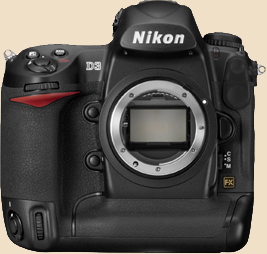
The announcement of the new Nikon D3 professional DSLR has created a buzz among the brand's aficionados, and for good reason:
Since the arrival of the first Nikon "D", the D1 in 1999, absolutely all Nikon digital SLR cameras have used an APS-C format sensor of about 23.7 x 15.7mm.
This format, dubbed "DX", is smaller than the traditional 36 x 24mm film and had been chosen to solve several technical problems, such as color fringing at the edge of images, and to reduce the cost of the camera.
(a large piece of silicon being more expensive!)
The use of this "reduced" format implied a focal length conversion.
Indeed, a multiplication factor of 1.5 had to be applied to the lenses to obtain the equivalent angle of view previously obtained on film cameras.
This "mandatory" phenomenon was advantageous for telephoto lenses (a 200mm becoming a 300mm) but penalized wide-angle lenses.
Thus, a wide-angle lens of 24mm used on a digital body with a "DX" sensor gave an angle of view equivalent to an almost standard lens of 36mm on a 24x36mm film body, etc...
The Nikon D3 marks a decisive turn, with the return to a so-called "full-frame" sensor of 36 x 24 mm...
...re-named for the occasion "FX" format!
Thus, the two main positive consequences of this change are:
- the possibility to use lenses at their real focal lengths again, thus offering more comfort and choice in wide angles: the use of the AFS 17-35 2.8D lens allowing to work at the true focal length of 17mm again (something that has been impossible for 8 years!) and even to use the brand new AF-S 14-24mm f/2.8G thus offering the possibility to work at 14mm with a record angle of... 114°!
- The other positive consequence is to benefit from a larger sensor surface allowing either to increase the number of pixels (an option not yet announced, but expected in the long term to compete with the Canon EOS 1Ds Mark III in the range of 20 million pixels), or to make bigger and more sensitive pixels, the option chosen for the D3.
Therefore, in practice, the Nikon D3 does not offer more resolution than the previous flagship of the range: the D2Xs!
Moreover, by counting precisely, one can even notice that the D3 announces a slightly lower resolution: 4256 x 2832 against 4288 x 2848 pixels for the D2X/D2Xs, which is 32 pixels less on the horizontal axis and 16 on the vertical axis (insignificant!)
However, the Nikon D3 offers more sensitive pixels, composed of small squares, the photosites, of 8.45 microns on a side, compared to only 5.5 microns for a D2X.
The sensitivity range of the Nikon D3 is extended, and goes from 200 to 6,400 ISO, compared to only 100 to 800 ISO for the D2X/D2Xs. The D3, in "boost" mode, can even reach the record value of 25,600 ISO (against "only" 3,200 ISO for the D2X/D2Xs).
But any increase in sensitivity involves an electronic gain and inevitably brings "noise" into the image (graininess, color deterioration, etc...).
In early November 2007, the Nikon D3 is still not officially available, but having had the opportunity to "play" with a D3 body for an hour, I conducted some tests to appreciate the image quality obtained at different ISO values, and to compare the results with my Nikon D2X.
The results presented below are not meant to be scientific tests, but simply a first "quick and dirty" trial.
This is quite far from the precision of the tests I usually perform.
(Shooting perfectly orthogonal test charts, with special lighting, double tripods, etc...)
Here, the shooting conditions were not great: indoors, hangar roof 20 meters away, variable incandescent lighting, slightly different white balance and contrast settings between the two bodies, etc...
The lens used for this test was the new AFS 14-24 2.8G, set at F8.0, and at 24mm for the Nikon D3 and at about 16mm for the Nikon D2X, in order to obtain "roughly the same image".
100% enlargement of a Nikon D2X image detail
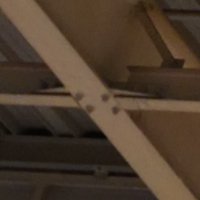
Reference image N°1,
Nikon D2X @ iso 400 at 100%
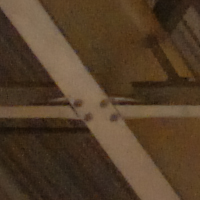
Reference image N°2,
Nikon D2X @ iso 800 at 100%
100% enlargement of a Nikon D3 image detail
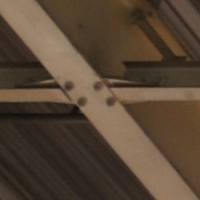
Nikon D3 @ iso 200
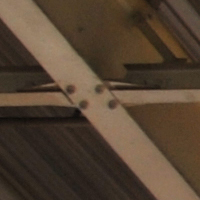
Nikon D3 @ iso 400
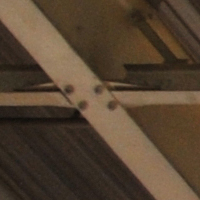
Nikon D3 @ iso 800
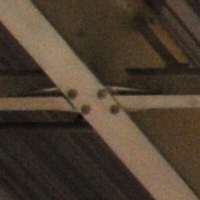
Nikon D3 @ iso 1600
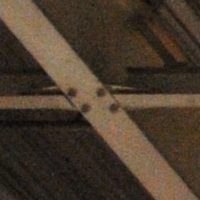
Nikon D3 @ iso 3200
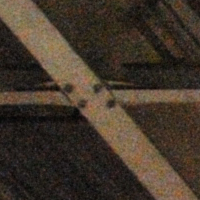
Nikon D3 @ iso 6400
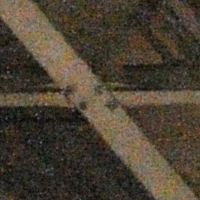
Nikon D3 @ iso 12800
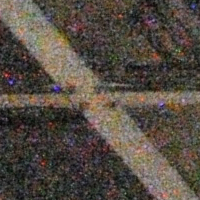
Nikon D3 @ iso 25600
Very preliminary conclusions regarding the D3's sensitivity
When directly comparing the "iso 400" image from the D3 to the reference D2X "iso 400" image, the difference is not striking, it seems just a tiny bit better defined.
However, the "iso 200" photo from the D3 is really cleaner.
When directly comparing the "iso 800" image from the D3 to the reference D2X "iso 800" image, the difference is clearly visible, the image from the D3 is cleaner with less grain.
The "iso 1600" image from the D3 is quite comparable to the D2X "iso 800" reference, maybe with a tad more noise.
Continuing to increase the D3's sensitivity:
- at "iso 3200", the grain is well present, but it's "not ugly", and the details and colors are right there... Largely usable.
- at "iso 6400", the grain increases with color "clumps" that slightly disturb the image.. but it's still usable!
- at "iso 12 800", the grain increases further, and the image loses color, giving an almost monochrome feeling and being dotted with small white spots... Objectively, this is the highest sensitivity still usable in extreme situations.
- Finally, at "iso 25 600", the grain increases further, and the image is covered in color artifacts that are too visible relative to the background subject... There, it's not really usable anymore.
The D3 obviously widens the gap with the D2X/D2Xs as soon as you increase the sensitivity, but this gap seems to me to be only one stop, maybe up to 1.5 stops, if you perform a careful post-processing of the images.
However, it must be highlighted (and I must admit!) that the D3's images are Jpegs "as is" directly out of the camera, whereas those from the D2X are "Nefs" (Raw) processed by Nikon-Capture and are therefore theoretically a tad cleaner.
But in any case, obtaining usable images with a sensitivity of 12 800 remains a record in itself!
Beyond the positive aspect of the sensitivity obtained thanks to the full-frame sensor, another concern remained:
the image quality, resolution, contrast, fringing... on the edges of the sensor and in the corners.
I am pleased to announce that this doubt is cleared for me: the sharpness in the corners is literally bluffing!
Below, a photo taken with the new AFS 14-24 2.8G:
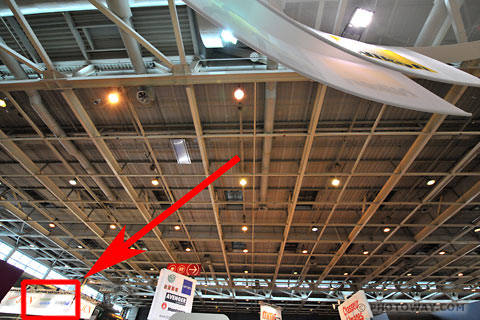
(Nikon D3 + AFS 14-24 2.8G, set to 14mm and at f:5.6)
And the 100% enlargement of the bottom left corner:
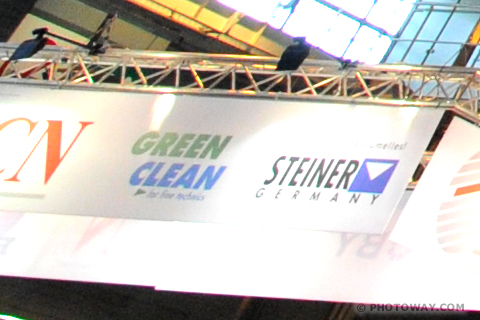
(Nikon D3 + AFS 14-24 2.8G @14mm and at f:5.6 - Zoom in 100% on corner)
Honestly, I was expecting a lot more fringing (lateral chromatic aberrations), especially since it's a Jpeg, so it hasn't undergone the very good fringe correction processing of Nikon Capture (but it seems that now an algorithm is integrated into the D3).
I also thought I would get a quite "smudgy" image given the extreme angle (like with the AFS 12-24 4.0DX, which does not excel at the edges) but it was nothing of the sort, the image is well-defined... impressive!
Having conducted hundreds of such tests over the years with 24x36mm film, I do not recall ever obtaining such a good image in a corner, especially with such an extreme wide angle; and to top it all off, it must be said that this photo was taken at ISO 3,200!!! (and that's downright astonishing!)
The D3 is really very good, but the new AFS 14-24 2.8G lens is incredible ("a killer"!): even at full aperture, at f:2.8, the image is almost identical!
Quite honestly, I think this lens is by far the best wide-angle zoom ever produced, across all brands.
Come on, one last test with my good old AFS 17-35 2.8...
also in the bottom left corner... at f:8.0 always ISO 3,200:
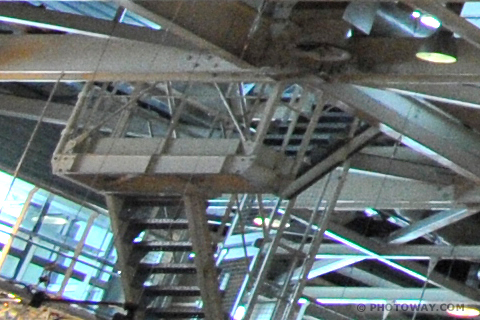
(Nikon D3 + AFS 17-35 2.8D @24mm and at f:8.0 - Zoom in to 100% corner)
It's not bad either!
Two other negative aspects can be considered with the return to a full-frame "FX" sensor:
geometric distortion and vignetting.
As for vignetting, we find the same observations as in the past with film: a good pro lens with a large diameter does not vignette at all if closed down by one stop, as is the case with the AFS 17-35 2.8 or the new AFS 24-70 2.8G that I tested.
For distortion, we clearly lose with the "DX" -> "FX" switch...
Example: the AFS 17-35 2.8 at 35mm shows a slight pincushion distortion in "FX" format whereas in "DX" format, which only uses the central part of the image circle, this distortion is not visible.
Note that the new AFS 14-24 2.8G has a "quite visible" distortion at 14mm just like the AFS 24-70 2.8G at 24mm.
Otherwise, the D3, with its "FX" format, is really a fabulous camera.
Its strengths:
- It retains the best of the D2Xs: build quality, material quality, etc... it's definitely Nikon.
- The screen seems really huge compared to the D2Xs,
- The viewfinder is "finally" larger, and of normal size like on an F5
- The dual Compact Flash card slots are ingenious.
- Resolution and color fringe control, in the corners and edges of images are really good for a full-frame 24x36! (at least with the 3 "race" optics that I tested: my good old AFS 17-35 2.8D, and the brand new AFS 14-24 2.8G and AFS 24-70 2.8G.)
- Generally speaking, the image quality is really impressive!
We might regret:
- Not having more resolution for studio or landscapes, but this might come quite quickly, with who knows... a D3X with 20 or 24 Million pixels!
- The weight: well yes, with a larger prism, a larger screen, etc... the D3 weighs about 200g more than the D2Xs, and it is noticeable.
No automatic sensor cleaning like on the brand new D300 announced at the same time as the D3.
And still no electronic coupling of the lens aperture, which for me is the only and last weakness to be corrected by Nikon. Indeed, it's always a cam that indicates to the lens, by a mechanical movement, the closing position of the aperture. The axial mechanical play that sometimes exists between the body and certain lenses can lead to a tolerance of 0.2 to 0.3 mm in rotation; this results in aperture closing discrepancies that can go up to 0.5 stops!!!
But correcting this problem would mean revising the lens range... so it's not for the immediate future... but after all, remember, 10 years ago, "AFS" lenses did not exist and it was another cam that "turned" the autofocus from the body.
Ultimate conclusion about the Nikon D3: I want one!
(in fact, I waited for the release of the D700, lighter for travel, to replace my venerable D2X).
Texts and Photos © Richard Soberka - www.photoway.com